Carpool
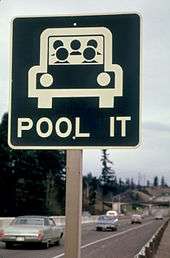
Carpooling (also car-sharing, ride-sharing and lift-sharing) is the sharing of car journeys so that more than one person travels in a car, and prevents the need for others to have to drive to a location themselves.
By having more people using one vehicle, carpooling reduces each person's travel costs such as: fuel costs, tolls, and the stress of driving. Carpooling is also a more environmentally friendly and sustainable way to travel as sharing journeys reduces air pollution, carbon emissions, traffic congestion on the roads, and the need for parking spaces. Authorities often encourage carpooling, especially during periods of high pollution or high fuel prices. Car sharing is a good way to use up the full seating capacity of a car, which would otherwise remain unused if it were just the driver using the car.
In 2009, carpooling represented 43.5% of all trips in the United States[1] and 10% of commute trips.[2] The majority of carpool commutes (over 60%) are "fam-pools" with family members.[3]
Carpool commuting is more popular for people who work in places with more jobs nearby, and who live in places with higher residential densities.[4] Carpooling is significantly correlated with transport operating costs, including fuel prices and commute length, and with measures of social capital, such as time spent with others, time spent eating and drinking, and being unmarried. However, carpooling is significantly less likely among people who spend more time at work, elderly people, and homeowners.[3]
Operation
Drivers and passengers offer and search for journeys through one of the several mediums available. After finding a match they contact each other to arrange any details for the journey(s). Costs, meeting points and other details like space for luggage are agreed on. They then meet and carry out their shared car journey(s) as planned.
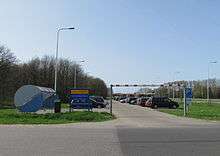
Carpooling is commonly implemented for commuting but is increasingly popular for longer one-off journeys, with the formality and regularity of arrangements varying between schemes and journeys.
Carpooling is not always arranged for the whole length of a journey. Especially on long journeys, it is common for passengers to only join for parts of the journey, and give a contribution based on the distance that they travel. This gives carpooling extra flexibility, and enables more people to share journeys and save money.
Some carpooling is now organized in online marketplaces or ridematching websites that allow drivers and passengers to find a travel match and/or make a secured transaction to share the planned travel cost. Like other online marketplaces, they use community-based trust mechanisms, such as user-ratings, to create an optimal experience for users.
Arrangements for carpooling can be made through many different mediums including public websites, social media, acting as marketplaces, employer websites, smartphone applications, carpooling agencies and pick-up points.
Initiatives
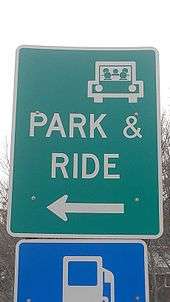
Many companies and local authorities have introduced programs to promote carpooling.
In an effort to reduce traffic and encourage carpooling, some governments have introduced high-occupancy vehicle (HOV) lanes in which only vehicles with two or more passengers are allowed to drive. HOV lanes can create strong practical incentives for carpooling by reducing travel time and expense.[5] In some countries it is common to find parking spaces reserved for carpoolers.
In 2011, an organization called Greenxc[6] created a campaign to encourage others to use this form of transportation in order to reduce their own carbon footprint.
Carpooling, or car sharing as it is called in British English, is promoted by a national UK charity, Carplus, whose mission is to promote responsible car use in order to alleviate financial, environmental and social costs of motoring today, and encourage new approaches to car dependency in the UK. Carplus is supported by Transport for London, the British government initiative to reduce congestion and parking pressure and contribute to relieving the burden on the environment and to the reduction of traffic related air-pollution, in London.[7]
However, not all countries are helping carpooling to spread: in Hungary it is a tax crime to carry someone in a car for a cost share (or any payment) unless the driver has a taxi license and there is an invoice issued and taxes are paid. Several people were fined by undercover tax officers during a 2011 crackdown, posing as passengers looking for a ride on carpooling websites. On 19 March 2012 Endre Spaller, a member of the Hungarian Parliament interpellated Secretary of the State X about this practice who replied that carpooling should be endorsed instead of punished, however care must be taken for some people trying to turn it into a way to gain untaxed profit.[8]
Cost sharing
Carpooling usually means to divide the travel expenses in equal parts between all the occupants of the vehicle (driver or passenger). The driver doesn’t try to earn money, but to share with several people the cost of a trip he would do anyway. The expenses to be divided basically include the fuel and possible tolls. But if we include in the calculation the depreciation of the vehicle purchase and maintenance, insurance and taxes paid by the driver, we get a cost around $1/mile. There are platforms that facilitate carpooling by connecting people seeking respectively passengers and drivers. Usually there is a fare set up by the car driver and accepted by passengers, because they get an agreement before trip start.
The second generation of these platforms is designed to manage urban trips in real time, using the travellers’ smartphones. They make possible to occupy the vehicle’s empty seats on the fly, collecting and delivering passengers along its entire route (and not only at common points of origin and destination). This system automatically performs an equitable sharing of travel costs, allowing each passenger to reimburse the driver a fair share according to the benefit actually gained by the vehicle usage, proportional to the distance traveled by the passenger and the number of people that shared the car.
History
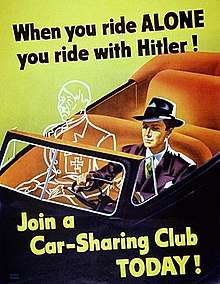
Carpooling first became prominent in the United States as a rationing tactic during World War II. It returned in the mid-1970s due to the 1973 oil crisis and the 1979 energy crisis. At that time the first employee vanpools were organized at Chrysler and 3M.[9]
Carpooling declined precipitously between the 1970s and the 2000s, peaking in the US in 1970 with a commute mode share of 20.4%. By 2011 it was down to 9.7%. In large part this has been attributed to the dramatic fall in gas prices (45%) during the 1980s. In the 1990s it was popular among college students, where campuses have limited parking space. Together with Prof. James Davidson from Harvard, Dace Campbell, a Washington computer scientist, and several others, he later began to investigate the feasibility of further development although the comprehensive technologies were not commercially available yet at the time. Their work is considered by many, a forerunner of carpooling & ride sharing systems, a precursor to technology developed by Garrett Camp, Travis Kalanick, Oscar Salazar and Conrad Whelan at Uber.[10][11][12][13]
The character of carpool travel has been shifting from "Dagwood Bumstead" variety, in which each rider is picked up in sequence, to a "park and ride" variety, where all the travelers meet at a common location. Recently, however, the Internet has facilitated growth for carpooling and the commute share mode has grown to 10.7% in 2005. In 2007 with the advent of smart phones and GPS, which became commercially available, John Zimmer and Logan Green, from Cornell University and University of California, Santa Barbara respectively, rediscovered and created carpooling system called Zimride, a precursor to Lyft. The popularity of the Internet and smart phones has greatly helped carpooling to expand, enabling people to offer and find rides thanks to easy-to-use and reliable online transport marketplaces. These websites are commonly used for one-off long-distance journeys with high fuel costs.[3][12][14] Carpooling is also becoming popular in Canada, with two companies sharing the market, Kangaride in Eastern Canada and Poparide in Western Canada.
In Europe, long-distance car-pooling has become increasingly popular over the past years, thanks to Germany's Mitfahrgelegenheit (carpooling.com), and France's BlaBlaCar which acquired the former in 2015.[15] According to their respective websites, in early 2015 these online platforms counted more than 6 million[16] and 10 million[17] users respectively, across Europe and beyond.
Other forms
Carpooling exists in other forms:
- Slugging is a form of ad hoc, informal carpooling between strangers. No money changes hands, but a mutual benefit still exists between the driver and passenger(s) making the practice worthwhile.
- Flexible carpooling expands the idea of ad hoc carpooling by designating formal locations for travelers to join carpools.
- Real-time ridesharing allows people to arrange ad hoc rides on very short notice, through the use of smartphone applications or the internet. Passengers are simply picked up at their current location.
- Odd-Even formula, a kind of car pool concept was adopted by state government in Delhi, India.
- Multi-hop ride sharing denotes the re-combination of existing rides (e.g., A to X, X to B) to travel from A to B via X.[18]
- Long distance ridesharing, in which the distances traveled are long range, in contrast to short-distance or local ridesharing. It is substantially and legally different from the local mode of peer-to-peer ridesharing, where the use of modern technology honors fast and secure signaling and reporting, but where rides are priced differently from local ridesharing. The idea was legally struck down in California.[19]
Challenges
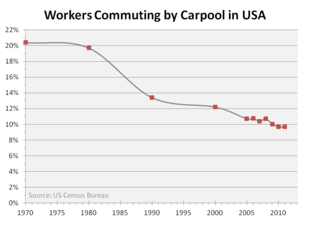
- Flexibility - Carpooling can struggle to be flexible enough to accommodate in route stops or changes to working times/patterns. One survey identified this as the most common reason for not carpooling.[5] To counter this some schemes offer 'sweeper services' with later running options, or a 'guaranteed ride home' arrangement with a local taxi company.
- Reliability - If a carpooling network lacks a "critical mass" of participants, it may be difficult to find a match for certain trips. The parties may not necessarily follow through on the agreed-upon ride. Several internet carpooling marketplaces are addressing this concern by implementing online paid passenger reservation, billed even if passengers do not turn up.
- Riding with strangers - Concerns over security have been an obstacle to sharing a vehicle with strangers, though in reality the risk of crime is small.[20] One remedy used by internet carpooling schemes is reputation systems that flag problematic users and allow responsible users to build up trust capital, such systems greatly increase the value of the website for the user community.
- Overall efficacy - Though carpooling is officially sanctioned by most governments, including construction of lanes specifically allocated for car-pooling, some doubts remain as to the overall efficacy of carpool lanes. As an example, many car-pool lanes, or lanes restricted to car-pools during peak traffic hours, are seldom occupied by car-pools in the traditional sense . Instead, these lanes are often empty, leading to an overall net increase in fuel consumption as freeway capacity is intentionally contracted, forcing the solo-occupied cars to travel slower, leading to reduced fuel efficiency. Further, many of the vehicles are occupied by passengers that would nevertheless consist of multiple passengers, for example a parent with multiple children being escorted to school.
- In 2012, the Queensland government announce it would end car pool lanes (known as Transit Lanes) claiming they were creating congestion and delays. The move was supported by the RACQ motoring group.[21]
In popular culture
Cabbing All the Way is a book written by author Jatin Kuberkar that narrates a success story of a car pool with twelve people on board. Based in the city of Hyderabad, India, the book is a real life narration and highlights the potential benefits of having a car pool.[22]
See also
- Flight sharing
- Hitchhiking
- Public transportation
- Real-time ridesharing
- Rota (schedule)
- Shared transport
- Slugging
- Sustainable transportation
- Traditional car sharing and peer-to-peer carsharing
- Transportation network company connects drivers with riders who pay a fee.
- Vanpool
- When You Ride Alone You Ride with bin Laden
Notes
- ↑ "U.S. Department of Transportation, Federal Highway Administration, 2009 National Household Travel Survey". U.S. Federal Highway Administration. Archived from the original on 23 October 2013. Retrieved 2014-01-29.
- ↑ Park, Haeyoun; Gebeloff/, Robert (28 January 2011). "Car-Pooling Declines as Driving Becomes Cheaper". The New York Times.
- 1 2 3 Stephen DeLoach and Thomas Tiemann. Not driving alone: Commuting in the Twenty-first century. Elon University Department of Economics. 2010.
- ↑ Nathan Belz and Brian Lee. Composition of Vehicle Occupancy for Journey-To-Work Trips: Evidence of Ridesharing from the 2009 National Household Travel Survey Vermont Add-on Sample. Transportation Research Board 2012.
- 1 2 Jianling Li, Patrick Embry, Stephen P. Mattingly, Kaveh Farokhi Sadabadi, Isaradatta Rasmidatta, and Mark W. Burris. Who Chooses to Carpool and Why? Examination of Texas Carpoolers. Transportation Research Record, 2007.
- ↑ "GreenXC Website". GreenXC About. Retrieved 26 June 2011.
- ↑ "Source: The state of European Car Sharing, Car Sharing development strategy of greater London, p. 96-98: white-paper by Momo (European research project on sustainable mobility patterns), June 2010" (PDF). Retrieved 2014-01-29.
- ↑ "Archived copy". Archived from the original on 30 May 2012. Retrieved 2012-04-06. Demokrata, 19 March 2012
- ↑ Marc Oliphant & Andrew Amey. Dynamic Ridesharing: Carpooling Meets the Information Age. 2010.
- ↑ Erik Ferguson. The rise and fall of the American carpool: 1970–1990. Transportation 24.4. (1997)
- ↑ Elizabeth Chen.
- 1 2 Chan, Nelson D. & Susan A. Shaheen (2012) Ridesharing in North America: Past, Present, and Future. Archived 4 February 2014 at the Wayback Machine. Transport Reviews 32 (1): 93–112.
- ↑ http://www.businessinsider.com/uber-travis-kalanick-bio-2014-1
- ↑ https://venturebeat.com/2013/05/23/lyft-races-ahead-with-60m-in-funding-but-what-challenges-lie-ahead/
- ↑ "Ride-sharing in Europe: the race between BlaBlaCar and Carpooling.com". 7 February 2014.
- ↑ https://www.carpooling.com/about/%5Bpermanent+dead+link%5D
- ↑ "Archived copy". Archived from the original on 25 February 2015. Retrieved 20 February 2015.
- ↑ Teubner, T. and Flath, C. M. (2015) The Economics of Multi-Hop Ride Sharing: Creating New Mobility Networks Through IS Business & Information Systems Engineering 57(5), 311-324
- ↑ "Carpooling enters the US, brings long distance rides to Uber users". tnooz. Retrieved 2018-02-22.
- ↑ "Hitchhiking: a Viable Addition to a Multimodal Transportation System: Prepared for National Science Foundation, 1975". Trid.trb.org. 1976-02-04. Retrieved 2014-01-29.
- ↑ "Transit lanes video|RACQ backs plan to scrap T2 lanes, Brisbane". 2013-12-22. Archived from the original on 2013-12-22. Retrieved 2018-04-03.
- ↑ Cabbing All the Way
External links
| Wikimedia Commons has media related to Carpooling. |
| Wikivoyage has travel information for ride sharing. |